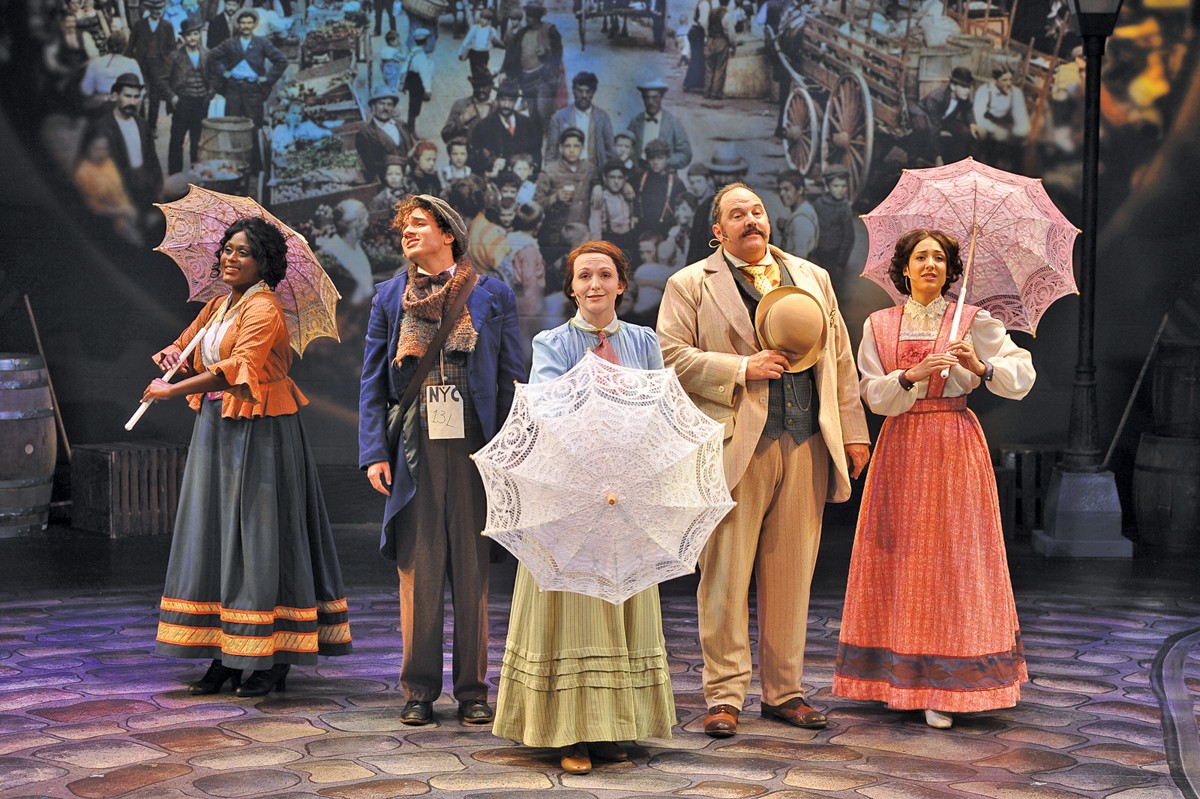The crew at the picturesque Porthouse Theatre has delivered a big slice of Americana pie with Tintypes, a musical of equal parts patriotism, vaudeville, show tunes and slapstick comedy.
For those who aren't photography buffs, a tintype is an old-fashioned style of photograph using a raw film positive on a strip of metal. It's a fitting title, as the production is laid out as an anthology of short skits, musical numbers and vignettes, each capturing an event or moment of time typical of the period. The result is a show that's as about as American as a bald eagle draped in the flag while flying over a Navy warship with a bacon cheeseburger in its mouth.
Written by Mary Kyte, Mel Marvin and Gary Pearle, Tintypes captures an often-overlooked period of American history between the Civil War and the First World War, when our nation made its share of strides in technology, politics, infrastructure and entertainment.
The ensemble cast takes on numerous roles throughout, but there are certain actors who tend to portray the same authority figure or character type. For example, Teddy (Mavis Jennings) is often seen as Theodore Roosevelt in his ascension from war hero to vice president and later the presidency, and Anna (Josy Soriano) often portrays singer Anna Held in her likeness on and off the stage.
Other characters are slated for similar roles with an overarching theme: Charlie (Devin Pfeiffer) as the new immigrant trying to fit in; Susannah (Shamara Costa) as a housemaid or humble worker craving respect and more out of life; and Emma (Samantha Kennett) as either the strong-willed, women's rights advocate influenced by anarchist Emma Goldman or the femme comedy foil for the characters. These roles are usually confined within the pantomimed skits that act as the glue holding the narrative together.
The play is divided into multiple themed sections, each highlighting the extraordinary talent on stage. Each character is given a chance to introduce themselves with a short musical number before showing their incredible harmony together with songs like "Kentucky Babe" and "I'm Goin' to Live Anyhow, 'Til I Die."
Soriano, making her debut at Porthouse, showcases her operatic falsetto in numbers such as "If I Were on the Stage" and "It's Delightful to be Married," the latter co-written by Held herself. Soriano's sarcasm and wit as Held are equally appreciated.
Costa, in her seventh production with Porthouse, dominates the stage with an injection of soul and pain in songs such as "Nobody," and often takes center stage as a narrator. Her mesmerizing presence would make the late Lynne Thigpin — nominated for a Tony for the role in its original Broadway run — very proud.
Pfeiffer, one of the current Kent State students in the production, illustrates his strengths with a plethora of expressions and mannerisms that mimics Chaplin's signature appeal. His singing voice is also top-notch in numbers like "Then I'd be Satisfied With Life."
Another Kent State theater student, Kennett already possesses a keen balance of comedic and dramatic mastery. Her singing prowess is best showcased in her many duets, especially alongside Jennings in "What It Takes to Make Me Love You."
Jennings himself boasts a booming, commanding vocal range that instantly reels you in, both in his normal baritone in numbers like "When It's All Goin' Out and Nothin' Comin' In" and with a slight droop singing in Teddy Roosevelt's tough-guy inflection in "El Capitan."
Director Eric van Baars tackles the play with full confidence, executing the show with boisterous, unapologetic camp that retains an old-timey charm. The theater's decision to produce this period piece is very much welcome in the grand scheme of the Cleveland theater scene, as it has seldom toured across the country since its initial 1980 run on Broadway.
Baars has also succeeded in keeping the production going at a fairly fast-paced clip, with musical numbers wonderfully strung together thanks to conductor Jennifer Korecki and her orchestra, which match the pep and energy of the cast with bombastic show tunes and soft ballads.
The commitment to the look and feel of the surroundings is impressive, from the newspapers strung up on clotheslines to the soapboxes and old-fashioned carriages and bicycles utilized. The fake cobblestone center stage helps complete the backdrop of 1890s New York.
The set even transforms during the vaudeville portions, with fashionable red curtains drawn and sideshow attraction posters adorning the stage. The sketch and standup comedy in these scenes still finds a way to elicit a smile from the audience while being heavily outdated without context.
Tintypes appropriately concludes with "Smiles," where the ensemble reminds each other that the smiles they have from their compatriots are the ones that "steal away the teardrops." Similarly, one would find it a challenge to not find joy and a wide-eyed smile in even its schmaltziest moments. With incredible talent and timeless music, the folks at Porthouse earn a star-spangled standing ovation for their execution.


